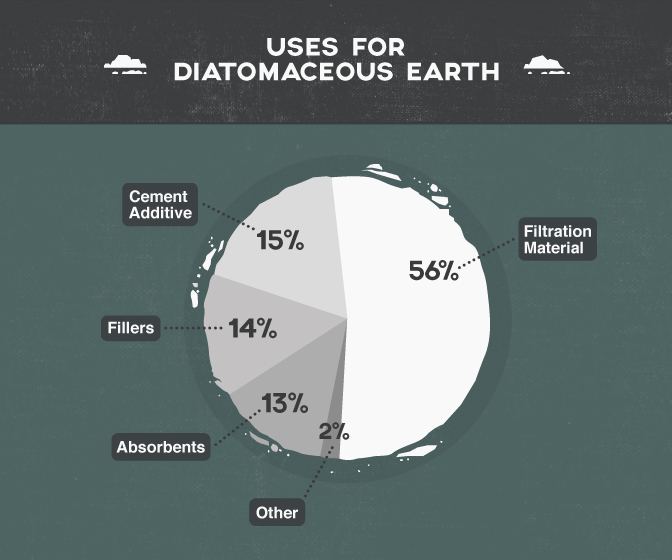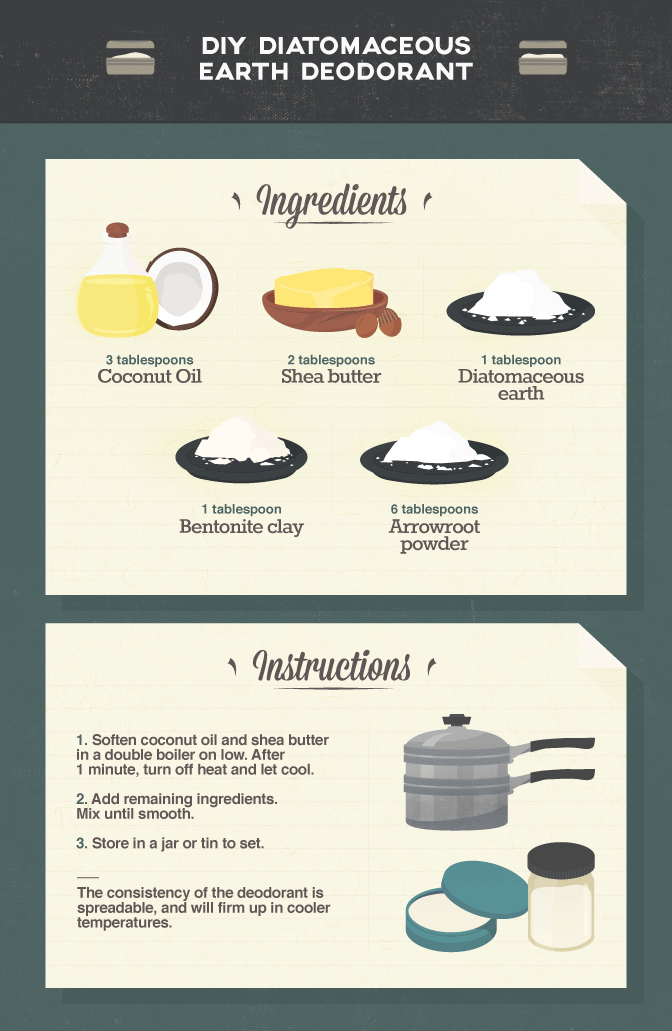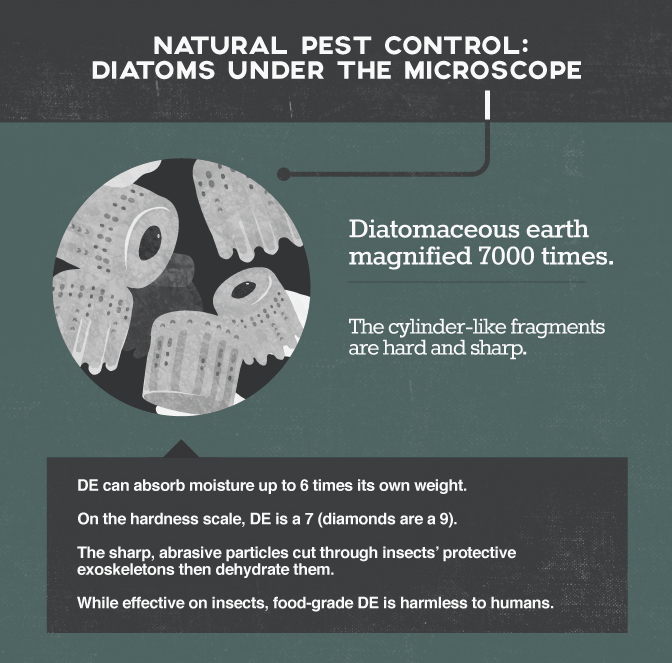Down to Earth
9 Ways to Use Diatomaceous Earth
It may be hard to believe, but the same substance first used to stabilize nitroglycerin to make more efficient dynamite can also be used to make a non-toxic toothpaste, control harmful pests such as bedbugs and mites, clarify beer and wine, and maybe even help to slow degenerative diseases such as osteoporosis and Alzheimer’s.
Diatomaceous earth (DE) is made up of the microscopic fossilized shells of ancient single-celled algae called diatoms. Composed of roughly 88 percent silica, DE makes up 26 percent of the Earth’s crust and is found in the sediments of rivers, streams, lakes, and oceans across the globe. DE is harmless, and science is beginning to discover a whole host of uses for it, some of which are nothing short of revolutionary.

Building Materials
Although Peter Kasten is typically credited with discovering DE in the 1830s in northern Germany, ancient Egyptians were aware of DE’s benefits as early as 2630 BCE. When analyzing the contents of blocks used to build the famous pyramids, researchers found that some were made with limestone reconstituted with fine silica particles, or DE. This addition helped to improve the resulting cement’s compressive strength. Recent research also shows that DE can help make self-repairing concrete. The science behind biomineralization is complex, but in a nutshell, DE protects naturally occurring bacteria from concrete’s high pH environment, which in turn allows the bacteria to produce enough calcium carbonate to fill cracks as they occur.
Filtering Beer, Oil, and Wine
Brew masters have turned to DE for years to clarify beer. When beer is brewed, all kinds of particles are left over, creating a turbid, cloudy beverage. With the possible exception of beers like Hefeweizen, most consumers want a beer that doesn’t look like a muddy lake. This is where DE comes in. Because it has such a large surface area, the powdery substance can coat a filter surface to form what is known as a cake. The beer passes through the layers of this cake – composed of finer or coarser grades depending on the level of clarification required – and the residue is left behind, resulting in a more aesthetically pleasing beverage. The same principle holds true of wines and oils.
Cosmetics
DE is an incredibly stable material that resists degradation, even when exposed to sunlight. It’s also highly absorbent, which is why it’s used in natural and homemade deodorants. Similar to talc in texture and color, DE is regularly used as an anti-caking agent in cosmetics such as facial powder, foundation, and eye shadow. And when used as a bulking agent, DE makes powder-based makeup more slippery, and therefore easier to apply. By using natural makeup products comprised of DE, consumers can reduce their exposure to the many carcinogenic chemicals found in modern cosmetics.

Environmental Remediation
We’ve already discussed DE’s ability to filter beer, wine, and oil; it may also prove useful for filtering other substances, such as polluted wastewater. Ceramic filter candles made with DE can make water potable by removing pathogenic protozoa and bacteria (although less is known about DE’s ability to remove viruses). DE can also aid in the absorption of textile dyes in wastewater. One study in the Journal of Environmental Management found that DE adsorbs methylene blue, hydrolyzed reactive black, and yellow dyes in the presence of an electrostatic interaction. This could be useful in highly industrialized places like China, where rivers near clothing manufacturing plants often take on the color of the fashion du jour.
Feed for Animals
When food-grade DE is added to animals’ feed, it may have a huge positive impact on animal health. In addition to controlling ticks, fleas, worms, and parasites, DE can improve the quality of coats and hooves, and promote better egg production in chickens. Farmers also insist it reduces the fly population and cuts down on manure odor. DE may foster improved bone formation, as well. One study found that chickens fed reduced amounts of silicon dioxide, a component of DE, suffered from poor bone formation.
Pest Control
As a highly abrasive, porous material, DE is well-known as a pesticide that can be used without fear of exposing pets, children, or anything else to dangerous chemicals. Instead of exploding insects from the inside, like certain conventional chemicals, DE, in either powder or wettable powder spray form, essentially cuts through the protective layer of insects and dries them out. And unlike crystalline DE, which can be harmful when inhaled, food-grade amorphous DE poses no known risk to humans.

Hygiene
Since a lot of toothpaste brands contain harmful chemicals such as sodium lauryl sulfate, many homesteaders are opting to make their own toothpaste with food-grade DE, natural flavors like mint, and other benign ingredients. The same abrasive quality that makes DE good for polishing metal makes it safe for cleaning teeth, while being gentle enough to avoid damaging enamel. Other hygiene benefits have been cited as well. For example, many people who suffer from chronic acne swear DE helps. While there’s little science to back up their claims, empirical evidence suggests that DE may soak up some of the toxins responsible for producing annoying pimples. DE is also used in soap and to control halitosis, otherwise known as bad breath.
Insulation
Asbestos was commonly used to insulate buildings, ships, and cars, among other things, until we realized it is incredibly harmful to human health, particularly when unearthed during demolition or renovation. Because it is a poor conductor of heat and electricity, DE is often used to replace asbestos in certain applications, such as in boilers and blast furnaces. In addition to resisting shrinkage, DE maintains its integrity at high temperatures, and doesn’t produce any emissions that might harm humans or animals. DE can also be used as sound-absorbing insulation, so if you like to jam at night while the neighbors are sleeping, take note.
Restoring Good Health
Probably the most exciting new research on DE encompasses potential medical benefits. But this is also the part of the story where we have to tread very carefully and balance empirical evidence with incomplete research about a material that has existed for millions of years. That being said, many green living advocates consume DE for purported health benefits. When DE is added to the diet, a small amount of silica is absorbed in the body. Silicon is the third most abundant trace element in the human body, prevalent in human hair, nails, and skin at one to ten parts per million.
Though we can get silicon, which is basically silica without the oxygen, from plant-based foods like oats, barley, polished rice, fruit, vegetables, water, and beer, it may not be bioavailable. That means in some situations our bodies aren’t able to use the silicon to perform certain functions, such as restoring connective tissue in the aorta, trachea, bone, and skin, or lowering blood pressure. If we can find bioavailable forms of silica or silicon, then it might be possible to slow the onset of degenerative diseases.
A study published in Nutrition & Metabolism found that aluminum in our bodies may be associated with Alzheimer’s disease as well as Parkinson’s, and dementia. This research also shows that silicic acid can reduce the bioavailability of aluminum, which in turn helps to slow down its neurotoxicity. Given that Alzheimer’s is the sixth leading cause of death and affected five million Americans last year, finding a preventative solution – especially one as simple as consuming DE – could save scores of lives. Of course, more research needs to be done before this can be considered conclusive, but the early results are promising. DE may also help improve digestion, promote detoxification, and even provide an antacid affect for unsettled stomachs.
As researchers discover more innovative uses for DE, we have to ask ourselves: Is it sustainable to use up the fossilized remains of millions of ancient single-celled organisms? After all, it took eons for them to accumulate, and DE is harvested in open pit mines. Fortunately, because it’s so soft, DE does not need to be blasted. But hauling the ore to a processing plant where it is first crushed and then dried using vast amounts of heat requires a great deal of energy, a scarce commodity that also emits earth-warming greenhouse gas. Still, given the breadth of toxic materials present in our environment and the number of people using harmful chemicals on their skin or in their homes and gardens, DE offers a benign alternative that is ultimately safer for everyone.
Embed the article on your site

